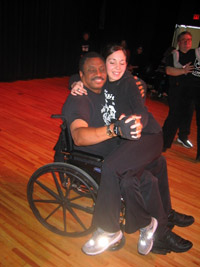Activities for Children, Parents, and Teachers
Teaching children about disabilities is simple: Begin by talking about them. Children learn compassion and understanding when we teach them to value diversity and accept differences.
The following activities will help children experience what life would be like with a disability. The follow-up discussion questions are the most important part of each activity. Encouraging children to explain how they felt will help them learn how to interact with people with disabilities, since they will have a better understanding of what a person with a disability experiences.
Avoiding talking about disabilities only reinforces discomfort with the subject and perpetuates negative attitudes. When children are taught to talk openly about their differences, they understand the disability and learn to look at the person instead.
Mirror, Mirror
Give each child a mirror and a piece of paper. Ask them to sit on the floor and place the mirror so they can see the reflection of the paper. Have them write their name on the paper while they look at the paper only in the mirror. After they accomplish the task, ask them how it felt to struggle to write their own name, something they have done hundreds of times, especially when other people watched them. Ask them: How did you do? How did you feel? Were you frustrated? Embarrassed? If you see someone else having difficulty with a task you think is simple, how you would treat them?

A young woman sits on the lap of a man in a wheelchair.
Using a wheelchair should not be a scary thought, and exposure to wheelchairs and wheelchair users can help children learn that. Most people who use wheelchairs see them as devices that set them free, not as restrictive devices.
Courtesy of That Uppity Theatre Company
Using a Wheelchair
Spending time maneuvering a wheelchair is an opportunity for students to understand the barriers that people with physical disabilities can face. If possible, find a wheelchair you can borrow (many schools have them for emergencies), and let the children try to get around in it. Perhaps go outside, to a local store, or just around the classroom or home. Ask the children: How did people treat you while you were in a wheelchair? Did people stare? Did people ignore you and talk to the people you were with instead? What was it like to always have to look up to speak to people? What problems did you come upon? How did you deal with them? How do you think you will act when you see someone in a wheelchair?
Story Time
Sit down with a group of children. Explain that you are all going to make up a story together. Start with the first sentence, "Once upon a time in..." Go around the circle with each person adding a sentence. End the story after every person has added a sentence. Then, start a new story, but put a limitation on it. For example, the letter "r" is not allowed to be used. Children will become anxious, but explain to them that this is what many people with speech difficulties have to deal with every day. Ask: How did it feel to have to think hard about what you wanted to say? How did you come up with a sentence? Were you nervous with so many people watching you? How will you act when you meet someone that cannot speak like you do?
A New View
Take an old pair of eyeglasses and smear Vaseline on the lenses. Have children wear them around for a few minutes and navigate spaces both familiar and unfamiliar to them (please supervise). Explain that many people in the world have visual disabilities that affect how well they are able to see the world. Ask them: What was different about the world? How did you figure out where to walk? What other senses did you rely on? How did it make you feel not to be able to see the way you are used to? What will you do when you meet someone who cannot see very well?
Garbled Quiz
Prepare a "quiz" on any subject, but jumble the letters within words. Have students take the quiz, giving them a 10-minute time limit, and instructing them that they cannot ask questions. Most students will begin to be able to read the words, but with difficulty and with a need for more time. End the activity with a discussion about dyslexia and explain that many students experience something similar to the garbled words when they read. Ask the students: What did you have to do to be able to understand the words? How did it make you feel? Do you know someone with dyslexia?
Other
Explore existing programs developed to teach about people with disabilities. For example, the University of Oklahoma Health Science Center offers a kit that simulates the experiences of aging. The ASiST (Aging Simulation Sensitivity Training) kit provides the tools to simulate vision loss, hearing loss, neuropathy, aphasia and mobility/balance issues (http://www.ouhsc.edu/okgec/ASiSTKits.asp). Or, Understanding Our Differences, Inc., has developed a curriculum with activities related to various disabilities. More information on this program can be found at http://www.understandingourdifferences.org/uod_nps.html.
Sources: Teaching Tolerance; What's the Difference? A Step Toward Understanding People with Disabilities; Jim Tuscher
Missouri History Museum exhibition
Americans with Disabilities Act: 20 Years Later.
June 26, 2010
to Jan 8, 2012
